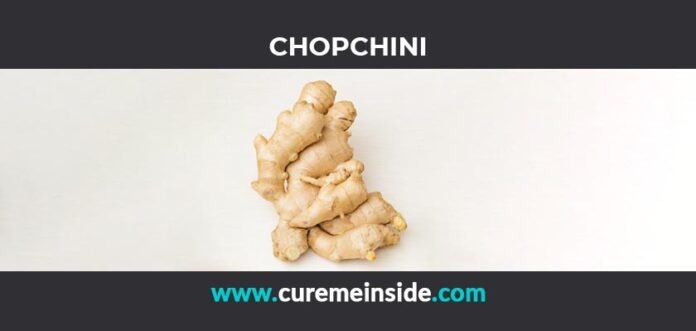Chopchini (Chinese Smile)
Chopchini, also known as China root, is a perennial deciduous climbing shrub that is used in traditional Chinese medicine.(HR/1)
It is mostly grown in mountainous areas of India, such as Assam, Uttarakhand, West Bengal, Manipur, and Sikkim. This plant’s rizhomes, or root, are known as “Jin Gang Teng” and are widely utilised for medicinal purposes. Chopchini has potent bioactive constituents that have antibacterial, anthelmintic, antioxidant, anticancer, hepatoprotective, anti-inflammatory, digestive, laxative, detoxifying, diuretic, febrifuge, tonic, antidiabetic, and analgesic properties. These actions aid in the treatment of dyspepsia, flatulence, colic, constipation, helminthiasis, leprosy, psoriasis, fever, epilepsy, insanity, neuralgia, syphilis, strangury (irritation at the base of the bladder), seminal weakness, and general debility, as well as helminthiasis, leprosy, ps
Chopchini is also known as :- Smilax china, Chopcheenee, Kumarika, Shukchin, China root, China Pairu, Parangichekkai, Pirngichekka, Sarsaparilla
Chopchini is obtained from :- Plant
Uses and benefits of Chopchini:-
As per several scientific studies, uses and benefits of Chopchini (Smilax china) are mentioned as per below(HR/2)
- Fluid retention : Chopchini’s diuretic properties aid with fluid retention management. It aids in the generation of urine and the reduction of water retention.
“Chopchini aids in the management of fluid retention symptoms in the body. Fluid retention is associated with ‘Shvathu’ in Ayurveda. Swelling develops in the body as a result of the accumulation of extra fluid in this condition. Chopchini contains a mutral (diuretic) function that aids in the removal of excess water or fluid from the body and alleviates the symptoms of fluid retention. Chopchini is a great vegetable to utilise to help with fluid retention. 1. Take 1-3 mg of Chopchini powder (or as prescribed by a physician). 2. Combine it with honey or milk to make a drink. 3. Take it once or twice a day, after meals, to relieve the symptoms of fluid retention. OR 1. Take 1 Chopchini pill or as advised by a doctor. 2. Swallow it with water twice a day, after meals, to relieve fluid retention symptoms. - Rheumatoid arthritis : “Aamavata, or rheumatoid arthritis, is an Ayurvedic condition in which the Vata dosha is vitiated and Ama accumulates in the joints. Amavata begins with a weakened digestive fire, resulting in an accumulation of Ama (toxic remains in the body due to improper digestion). Vata transports this Ama to various sites, but instead of being absorbed, it accumulates in the joints. Chopchini’s Ushna (hot) potency aids in the reduction of Ama. Chopchini also has a Vata-balancing effect, which helps to alleviate the symptoms of RRheumatoid arthritis such as joint pain and swelling. Rheumatoid arthritis symptoms can be relieved by eating Chopchini. 1. Take 1-3 mg of Chopchini powder (or as prescribed by a physician). 2. Combine it with a small amount of lukewarm water. 3. Take it once or twice a day after meals to obtain relief from Rheumatoid arthritis symptoms.
- Syphilis : Although there isn’t enough scientific proof to support Chopchini’s significance in Syphilis, it may aid in the treatment of the disease.
- Psoriasis : Psoriasis is an inflammatory skin condition that causes red, scaly patches. Chopchini’s anti-psoriatic properties make it useful for treating psoriasis when applied as a cream to the affected area. Because of its anti-inflammatory properties, it prevents the growth of bacteria and reduces skin inflammation. Chopchini contains an antiproliferative compound that aids in the treatment of psoriasis. It stops or slows down cell reproduction and proliferation.
Video Tutorial
Precautions to be taken while using Chopchini:-
As per several scientific studies, below precautions should to be taken while taking Chopchini (Smilax china)(HR/3)
Special precautions to be taken while taking Chopchini:-
As per several scientific studies, below special precautions should to be taken while taking Chopchini (Smilax china)(HR/4)
- Breastfeeding : Because there isn’t enough scientific data, it’s best to avoid Chopchini when breastfeeding or visit a doctor beforehand.
- Patients with diabetes : Because there isn’t enough scientific data, diabetic patients should avoid Chopchini or visit a doctor before doing so.
- Patients with heart disease : Chopchini has the potential to interfere with cardiac medications. As a result, it is often advised to seek medical advice before combining Chopchini with cardioprotective medications.
- Pregnancy : Because there isn’t enough scientific data, it’s best to avoid Chopchini during pregnancy or visit a doctor beforehand.
- Allergy : Because there isn’t enough scientific proof concerning Chopchini’s effects on allergies, it’s best to avoid it or consult a doctor before using it.
How to take Chopchini:-
As per several scientific studies, Chopchini (Smilax china) can be taken into the methods mentioned as per below(HR/5)
- Chopchini Paste : Take one to 6 gm or according to your demand of Chopchini powder. Add some coconut oil or water to it as well as make a paste. Apply this paste equally on the influenced area. Use this treatment three times a week to do away with dryness and swelling in situation of psoriasis.
How much Chopchini should be taken:-
As per several scientific studies, Chopchini (Smilax china) should be taken into the amounts mentioned as per below(HR/6)
Side effects of Chopchini:-
As per several scientific studies, below side effects need to be taken into consideration while taking Chopchini (Smilax china)(HR/7)
- Stomach irritation
- Runny nose
- Asthmatic symptoms
Questions asked frequently Related to the Chopchini:-
Question. Can Chopchini be used as a flavouring agent?
Answer. Chopchini is a flavouring ingredient that can be used in foods, beverages, and medications.
Question. Can Chopchini be used as a condiment?
Answer. Chopchini is used in the manufacture of soft drinks as a beverage condiment.
Question. What is the taste of Chopchini?
Answer. Chopchini has a little bitter flavour.
Question. What are the benefits of Chopchini for diabetes?
Answer. Chopchini’s antioxidant and anti-inflammatory characteristics may aid in the management of type 2 diabetes. Chopchini slows glucose breakdown and lowers blood sugar levels. It also protects pancreatic cells from injury, which aids insulin secretion.
Question. Does Chopchini works as an antioxidant?
Answer. Chopchini is an antioxidant because of its ability to scavenge free radicals. It protects cells from the oxidative damage produced by free radicals (reactive oxygen species).
Question. Does Chopchini help in spermatogenesis?
Answer. Chopchini, because of its antioxidant properties, may aid in spermatogenesis. It possesses free radical scavenging properties, which helps to increase the creation of new sperm cells while also raising sperm count.
Question. Is Chopchini is useful in ovarian cancer?
Answer. Chopchini may be beneficial in the treatment of ovarian cancer. It slows the proliferation of tumour cells, resulting in a smaller tumour.
Question. Can Chopchini help in minimizing allergic reactions?
Answer. Chopchini’s anti-allergic properties may aid to reduce allergic symptoms. It reduces the release of inflammatory molecules and inhibits the release of histamine. As a result, by not responding to infections, it aids in the reduction of allergic symptoms.
Question. Is Chopchini helpful in epilepsy?
Answer. Chopchini is thought to be helpful in the treatment of epilepsy because of its anticonvulsant and antiepileptic effects. It works by inhibiting the activity of specific neurotransmitters (GABA), which assist to relax the brain and prevent seizures.
Question. Can Chopchini harm the stomach?
Answer. Chopchini can irritate the stomach if consumed in large quantities.
Question. Can Chopchini cause asthma?
Answer. In certain situations, Chopchini dust exposure might result in a runny nose and asthma symptoms.
SUMMARY
It is mostly grown in mountainous areas of India, such as Assam, Uttarakhand, West Bengal, Manipur, and Sikkim. This plant’s rizhomes, or root, are known as “Jin Gang Teng” and are widely utilised for medicinal purposes.




